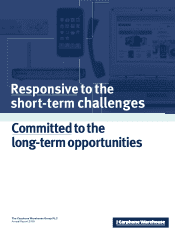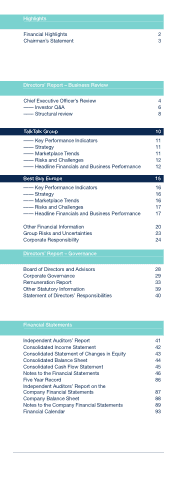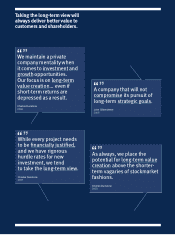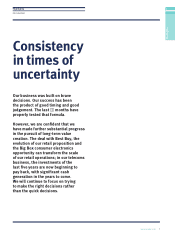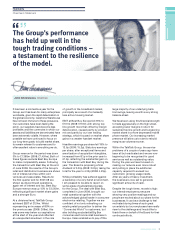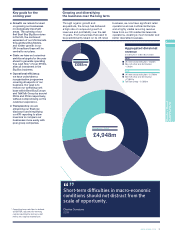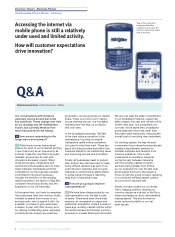Carphone Warehouse 2009 Annual Report Download - page 11
Download and view the complete annual report
Please find page 11 of the 2009 Carphone Warehouse annual report below. You can navigate through the pages in the report by either clicking on the pages listed below, or by using the keyword search tool below to find specific information within the annual report.
Directors’ Report –
Business Review
www.cpwplc.com 7
Q Your competitors and suppliers are
generally larger and better capitalised
than you: isn’t this a long-term
disadvantage?
A It is true that we are a relatively
small business in industries generally
populated with major multinationals, but
this has been the case throughout the
Group’s life. We have thrived on being
nimble, allowing us to minimise the time
between spotting opportunities and
mobilising to address them. Our ability
to come from nowhere to become the
number three in the UK residential
telecoms market is clear evidence of this.
We have also stayed focused and
stayed close to the customer. In both
our businesses, the rst thing we ask
ourselves is “What can we do better for
the customer?”. This may not result in
immediate prot maximisation, but it
does create a sustainable business
that makes fair margins over time and
creates barriers to entry through scale
and low pricing.
Q How does fibre deployment affect
your broadband business?
A The regulator OFCOM has recently
announced that it plans not to impose
any wholesale price regime on BT for
the resale of bre-based connectivity
to UK homes. Fibre networks facilitate
much higher broadband speeds than
existing copper networks. In theory,
this could allow BT to set a very high
wholesale price for bre, thus preventing
users of its network (such as us and Sky)
from reselling bre protably and giving
BT the opportunity to gain signicant
market share through marketing its own
superfast broadband product without
meaningful competition.
There are several aws to this theoretical
argument. Firstly, BT has a low retail
market share for an incumbent. This
means that it will be difcult to get a
good return on an expensive bre
deployment on a “go it alone” strategy
because they don’t have the density
of customers; they would need wholesale
customers to help defray the capital
outlay. We expect to work closely with
Openreach, the infrastructure arm of
BT, on the development of wholesale
products.
Secondly, demand for “raw” speed, while
growing, is still relatively low. BT’s ability
to take signicant retail market share
simply through a higher speed product,
with no compelling exclusive content, is
likely to be limited. At the same time,
the achievement of higher speeds
through the enhancement of the copper
infrastructure, and the rapid development
of compression technologies which
would allow much more effective data
transmission at prevailing broadband
speeds, could dampen demand for
bre-based products.
Finally, we all look to Virgin Media, the
cable-based broadband operator with its
own network, to see how their customers
are responding to their new, higher
speed products. If demand for 50Mbps
services picks up rapidly, then rapid bre
deployment with fair wholesale prices
will be the natural market response.
Q Won’t increasing customer usage
erode margins in the broadband
business?
A Customer usage increased, on
average, 60% year-on-year this year,
which was in line with our expectations.
We are designing our network for
continued strong trafc growth as
customers nd more to do on the internet
and will, over time, value reliability and
consistency from their ISP as much as
out-and-out speed.
Over the last two years we have been
increasing backhaul capacity into our
exchanges by up to ten times. The scale
economies of this process are very
healthy, with the operating cost to us
of running a gigabit circuit only being
twice that of running a 100 megabit
circuit. This means that our capacity-
related operating costs are effectively
capped for the medium term.
I believe that, as customers use
broadband for an ever-wider array of
services, metering will be an inevitable
next step in the marketplace, with
customers learning to pay for what they
use rather than having at rate tariffs.
Q Don’t you need content as part
of your broadband offer?
A The way customers are accessing
content is rapidly fragmenting. Although
Pay TV is a signicant part of the market,
an increasing amount of content is freely
available on the internet and this is only
going to grow over time. I don’t think that
telecoms businesses make good media
businesses, so we will continue to focus
on providing the best value and most
reliable network allowing our customers
to access content of their choice on the
web. How could we justify charging a
premium for content that customers
either don’t want or could nd
somewhere else for free anyway?
Q How do you compete with the
mobile networks’ direct distribution
strategies?
A The mobile networks have long been
competitors on the high street as well
as partners, and we have thrived within
this market dynamic for many years.
Customers are not all the same: for every
customer who is happy to stay with the
same network and deal with them direct,
there is another who wants to shop
around, try a wider range of handsets
and get impartial advice. That’s why
Carphone Warehouse exists.
Q Isn’t consumer electronics retailing
an unattractive sector?
A Not at all. It is estimated to be a
£30bn market in the UK alone. We
all love the technology we have in our
homes – music, home theatre, gaming,
even coffee machines and fridge freezers
– but generally we don’t love going to
buy it or having to make it work. Our
analysis of the UK market suggests
that competition is focused around
price rather than service, and while
most technology products aren’t
commoditised, they are sold that way.
Our goal is to open large stores with
deep ranges, well-informed staff, and
a high level of in-store interactivity
and after-sales service. We want it to
be a pleasure to come shopping for
technology, not a chore. The economics
of running 30,000 square foot stores
are much more attractive than stores
half the size, which our competitors
typically run, and the current property
market is providing us with some
compelling opportunities.

